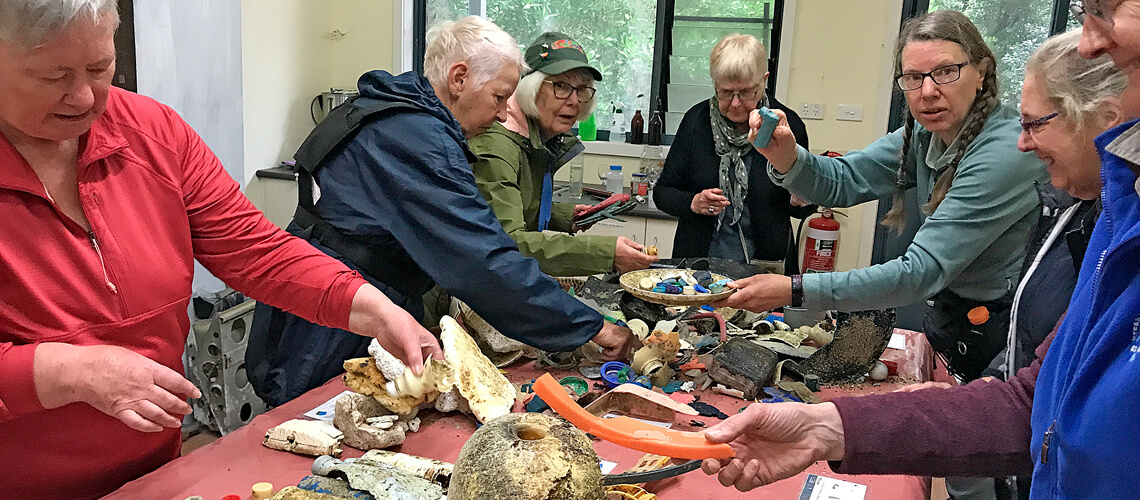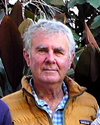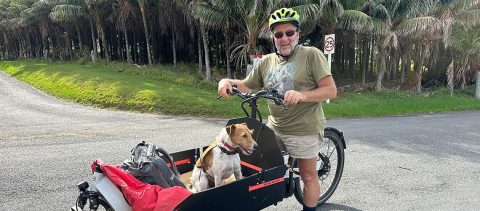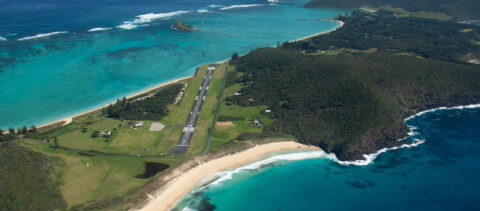In November the museum held a number of “ocean plastic” workshops.
In 2018, the local Lord Howe Island Plastic Action Group found a sponsor to provide four see-through bins to hold beach-collected plastic items.
The bins are located at Neds Beach, Lagoon Beach, Blinkie Beach and Cobby’s Corner. Visitors and locals see the bins and are prompted to pick up plastic debris while walking the beach. Others see the rubbish in the bins, and become aware of the issue of ocean plastic.
When nearly full (usually a few months), the bins are emptied into bags, and taken to the museum. Regular plastic sorting workshops are held at the museum where the contents are spread out on a table, and sorted into different categories.
The data are entered into a national database on ocean plastic. This gives lobby groups and governments data on what plastic items are ending up in our oceans, and helps make changes to reduce plastic impacting seabirds, turtles and mammals.
Volunteers sort through kilos of ocean plastic debris
Some of the participants in the November Birdweek contributed their time for two afternoon sessions sorting the plastic. They were amazed at the huge variety of items washing up on our beaches – toys, straws, pegs, car bumper bars, garden pots, bottles, fishing lures and floats, pipes, cigarette lighters, shoes and thongs, balloons, pens, cutlery etc.
What sort of ocean debris is collected?
Local staff Liv Rose, Bre Potter and Michael Tropiano had a morning session with Sally Montgomery. They sorted a single bag of plastic collected from Blinkie Beach – and prepared a video (see below). Many items were identifiable, and there were 1,745 fragments of broken plastic – most just the right size for a shearwater snack.
If you are visiting the island, find out if there is a workshop running while you are here, and join in.
The breakdown
In total it contained 2,641 pieces of plastic!
16 lollipop sticks
9 toothbrushes
6 hair combs
249 bottle caps
54 fishing glow sticks
1745 fragments
393 foam pieces
9 balloon clips
5 pegs
2 bike lights
1 coat hanger
2 gold pegs
11 balloons
4 thongs
2 rubber remnants
2 lightbulbs
3 glass bottles
1 aerosol can
2 burnt remnants
4 cable ties
8 food packaging
17 non-food packaging
11 strapping bands
18 rope scraps
8 buoys
5 fishing misc.
6 cigarette lighters
6 pens
3 cutlery
10 toys
29 miscellaneous
The bottom line
Scientists studying the impact of plastic debris on seabird colonies that nest on Lord Howe Island have found an increased number of dead chicks during the latest fledgling season — one with as many as 200 small pieces of plastic in its digestive system.
The Australian Marine Debris Database was created to enable volunteers and organisations who are running beach clean-up events to also collect data on what they were finding with a consistent methodology so it could be collated into a standardised national database of marine debris.
Since 2004 more than 21 million pieces of data have been entered into the Australian Marine Debris Database, creating a comprehensive overview of what amounts and types of marine debris are impacting beaches around the country.
The volume and variety of debris on the beaches of Lord Howe is increasing every year, and it is only through systematic study and cataloguing that we can hope to contribute to the effort to build the evidence that might eventually bring about global change, and reduce the creation of such rubbish at its sources.
Reference
The Australian Marine Debris Initiative
Tangaroa Blue website






